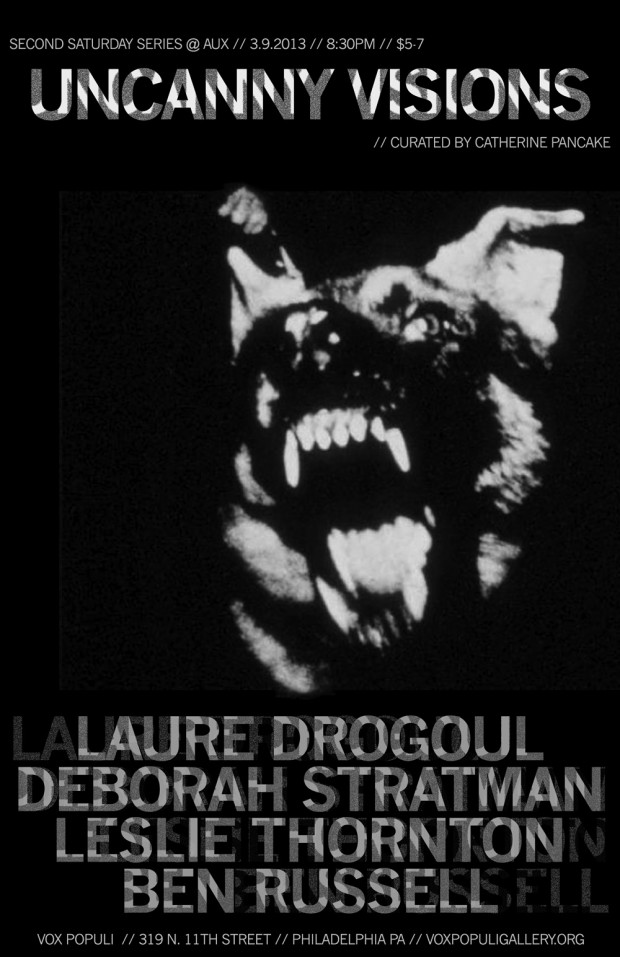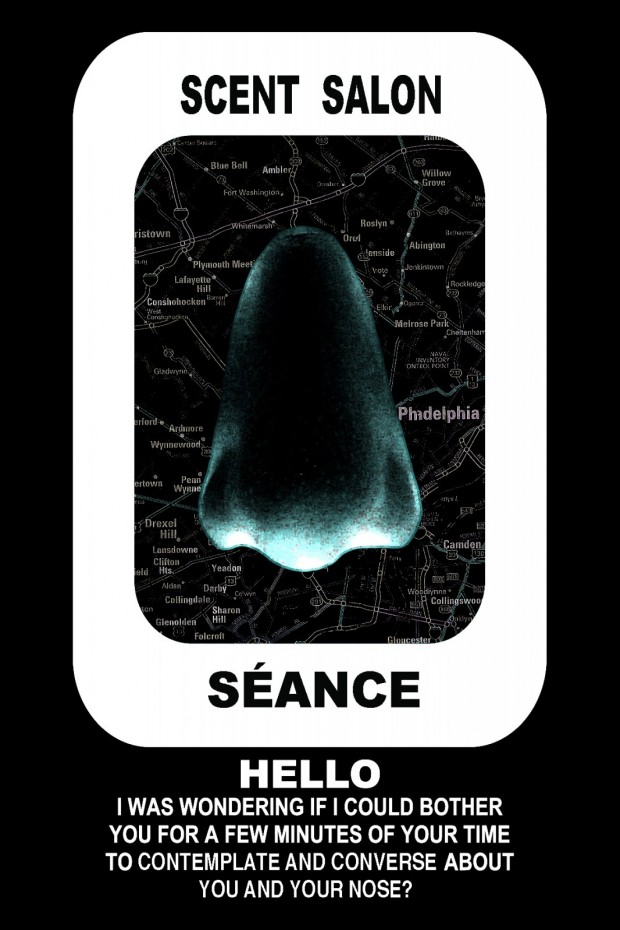
Second Saturday: Uncanny visions
3.9.13, 8:30pm
$5-7 sliding scale donation
AUX Performance Space
Curated by Catherine Pancake, Uncanny Visions is a series combining the lush private darkness of micro-cinema with the visceral charge of live cutting-edge performance art. The series takes inspiration from the concept of the uncanny, hoping to attract an audience who is drawn to the unfamiliar ready to take a few risks and participate in our communal unheimlich. Experimental cinema has a long historical engagement with the uncanny, crisscrossing psychoanalysis, altered states of mind, and visual illusion. Performance art’s obsession with the body and its extension through technology celebrates the flesh becoming art object and the anthropomorphism of the machine. Each Uncanny Vision event will join a program of experimental film with an original conceptual performance from national and internally renowned artists.
This Second Saturday program will feature Olfactory Factory, a sensory séance by Baltimore artist Laure Drogoul and films by Deborah Stratman, Leslie Thornton and Ben Russell.
————–
Scent Salon and Séance
Expand your olfactory consciousness! You are cordially invited to an evening of contemplation, conversation and divination based on the sense of smell.
This séance and scent salon is a performance about smell perception, memory and place. It is part of an ongoing work including an interactive Global Smell Map. Olfactory Factory
Laure Drogoul is an interdisciplinary artist, olfactory spelunker and cobbler of situations who lives in Baltimore, Maryland. She works in a wide range of media including large-scale public events. Her artworks are a combination of video, sculpture and performance that incorporate audience participation.
Laure has performed and exhibited at the Corcoran Gallery of Art, Washington Project for the Arts, Baltimore Museum of Art, The Chelsea Art Museum, Dixon Place and PS.122 in NYC among others. Laure Drogoul directs The 14Karat Cabaret, a performance program of Maryland Art Place and is a co-organizer and curator of the Transmodern Festival, which is a festival of provocative works by cultural experimenters from Baltimore and beyond.

————–
The Films of Uncanny Visions 2
Deborah Stratman
In Order Not To Be Here
2002 16mm, 33 minutes (Screened on DVD)
An uncompromising look at the ways privacy, safety, convenience and surveillance determine our environment. Shot entirely at night, the film confronts the hermetic nature of white-collar communities, dissecting the fear behind contemporary suburban design. An isolation-based fear (protect us from people not like us). A fear of irregularity (eat at McDonalds, you know what to expect). A fear of thought (turn on the television). A fear of self (don’t stop moving). By examining evacuated suburban and corporate landscapes, the film reveals a peculiarly 21st century hollowness… an emptiness born of our collective faith in safety and technology. This is a new genre of horror movie, attempting suburban locations as states of mind.
—
Deborah Stratman
O’er The Land<br />
2009, 16 mm film, 51:40 minutes (Screened on DVD)
A meditation on the milieu of elevated threat addressing national identity, gun culture, wilderness, consumption, patriotism and the possibility of personal transcendence. Of particular interest are the ways Americans have come to understand freedom and the increasingly technological reiterations of manifest destiny.
While channeling our national psyche, the film is interrupted by the story of Col. William Rankin who in 1959, was forced to eject from his F8U fighter jet at 48,000 feet without a pressure suit, only to get trapped for 45 minutes in the up and down drafts of a massive thunderstorm. Remarkably, he survived. Rankin’s story represents a non-material, metaphysical kind of freedom. He was vomited up by his own jet, that American icon of progress and strength, but violent purging does not necessarily lead to reassessment or redirection.
This film is concerned with the sudden, simple, thorough ways that events can separate us from the system of things, and place us in a kind of limbo. Like when we fall. Or cross a border. Or get shot. Or saved. The film forces together culturally acceptable icons of heroic national tradition with the suggestion of unacceptable historical consequences, so that seemingly benign locations become zones of moral angst.
—
Leslie Thornton
Peggy & Fred in Kansas
1987, 11 minutes (Screened on DVD)
Peggy and Fred in Hell, Thornton’s ongoing and open-ended series, maps a surreal, quasi-apocalyptic realm littered with the detritus of a pop culture bursting at the seams. Castaways in this wilderness of signs, Peggy and Fred are, as Thornton states, “raised by television,” their experience shaped by a palimpsest of science and science-fiction, new technologies and obsolete ones, half-remembered movies and the leavings of history. An exploration of the aesthetics of narrative form as well as the politics of the image, Thornton’s rigorously experimental oeuvre has forged a unique and powerful syntax.
Peggy and Fred in Kansas is one of the earliest installments in Thornton’s Peggy and Fred in Hell series. Thornton represents the outside world with archival footage of rugged terrain and industrial wastelands. We are introduced to the post-apocalyptic room where the children act and re-enact a disjointed play on media narratives. Though the seemingly isolated room is furnished with typically domestic objects, in the hands of the “children raised on television” these items appear as props for the purpose of performing adult affectation. Peggy and Fred channel their isolation like open radios, as if boredom were the frequency from which media is transmitted.
—
Ben Russell
Extra Terrestrial
(co-directed w/ Rhyne Piggott); 2004, 11 minutes
A deadpan video art reworking of E.T.- 1982’s highest-grossing movie. Extra Terrestrial peels away layers of sentimental narrative goo from its source, exposing a hard core of anxiety, loneliness and dread. Shifting the focus from character to interior, Russell and Piggott mine the landscape of a beige-carpeted rancher for new insights into the architecture of suburban alienation.
————–
Second Saturday is a new monthly programming series that highlights emerging practices in performance and media based arts. Please join us at AUX every second saturday of the month for performance, film, video, and sound works by national and international emerging and established artists.
————–
This event is presented with the support of The James S. and John L. Knight Foundation through the Knight Arts Challenge.




